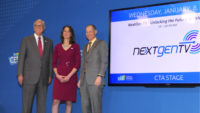CES 2020: Launch of First ATSC 3.0 NextGen TV Products
January 9, 2020
The Advanced Television Systems Committee (ATSC) launched 20 ATSC 3.0-enabled TV models. CTA chair of the video division board John Taylor introduced ATSC president Madeleine Noland, NAB president/chief executive and former Republican senator from Oregon Gordon Smith, and CTA president/chief executive Gary Shapiro. “This year NextGen TV joins the roster of new product announcements, with TV stations building out enhanced TV systems,” said Noland. “ATSC is proud to exhibit at CES for the first time — and we’ll be back next year.”
The first call for proposals for ATSC 3.0, also known as NextGen TV (or NEXTGEN TV), which enables 4K UHDTV (Ultra High Defintion TV), went out in March 2013. The standard was finalized three years later after multiple tests and trials. In June 2016, WRAL-TV in North Carolina launched ATSC 3.0, and, in 2018, the Pearl Consortium, comprised of numerous major broadcasters, opened its first test station in Phoenix, Arizona. The FCC quickly approved voluntary use of NextGen TV.

South Korea launched UHDTV in 2017; in the U.S., the NextGen TV system is expected to quickly roll out in more than 60 markets reaching 70 percent of the population, said Noland. Among the ATSC 3.0 demonstrations on the CES 2020 show floor are Sony’s TVs with integrated NextGen TV reception and Pearl TV and others part of the Phoenix Model Market’s NextGen TV application format, including Dolby’s Voice Boost.
Sinclair Broadcast Group and ONE Media will also enable live NextGen TV demonstrations with signals from Sinclair NBC Las Vegas station KSNV-TV, using an LG OLED TV for over-the-air and over-the-top converged applications. Gaian Solutions will show its AI & Data Lake powered NextGen TV Broadcast Platform as a service.
Noland (above center, with Smith and Shapiro) pointed out that NextGen is the first TV system built on an IP backbone, which allows it to deliver more choices and be more readily upgradeable. “Its deep feature set and flexibility promise new business opportunities, as well as advanced emergency messaging,” she said.
Smith described NAB’s long relationship with CTA. “When I became chief executive of NAB, Gary [Shapiro] told me that if broadcasters don’t get behind 3.0, it won’t work,” he said. “I’m happy to say that broadcasters are very much behind it. The momentum can’t be stopped.”
He noted that NAB and CTA have a “living lab” in Cleveland, Ohio and seven other cities. “Broadcasters uniquely serve values such as emergency alerts,” said Smith, who noted that this group also upholds “community decency standards and other civic standards for quality of life.” Shapiro said that, despite the roadblocks to NextGenTV, it is now “a model for the rest of the world.”

No Comments Yet
You can be the first to comment!
Sorry, comments for this entry are closed at this time.